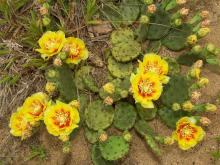Wildflowers, Grasses and Other Nonwoody Plants
Media

Species Types
Scientific Name
Alliaria petiolata
Description
Because each plant disperses a large number of seeds, garlic mustard can outcompete native vegetation for light, moisture, nutrients, soil, and space as it quickly colonizes an area.
Media

Species Types
Scientific Name
Cirsium altissimum
Description
Tall thistle is a native thistle that can grow to be 10 feet tall! To identify it, notice its leaves, which are unlobed (though they may be wavy or have only shallow, broad lobes), are felty-hairy beneath, and have prickles only along the edges.
Media

Species Types
Scientific Name
Polygonatum biflorum
Description
Solomon's seal grows statewide in moist, rich earth. The greenish-white flowers dangle like little bells beneath the leaves, under the gracefully arching stems.
Media

Species Types
Scientific Name
Pueraria montana
Description
Of the many invasive nonnative plants that were originally introduced to stop soil erosion and improve soils, kudzu is one of the worst. This “vine that ate the South” is often the first plant that comes to mind when we think of “invasive plants.”
Media

Species Types
Scientific Name
Lactuca floridana
Description
A true lettuce that can be eaten as a cooked or salad green, Florida lettuce has lavender to purplish blue flowers and grows statewide.
Media

Species Types
Scientific Name
Pyrrhopappus carolinianus
Description
One of several native plants called dandelions, Carolina false dandelion is an annual with sulphur yellow flowers and puffy seedheads.
Media

Species Types
Scientific Name
Opuntia humifusa (formerly O. compressa)
Description
Cacti make us think of the desert southwest, but there is at least one species native to Missouri. This prickly pear grows in glades, sand prairies, rocky open hillsides, and other dry, sun-soaked areas.
Media

Species Types
Scientific Name
Oenothera biennis
Description
True to its name, common evening primrose is the most common and widespread evening primrose in Missouri. It is most noticeable late in the season, when it reaches its greatest height and the flowers at the top are most visible.
Media

Species Types
Scientific Name
Oxalis stricta
Description
Yellow wood sorrel is both a garden weed and a wild edible. It has a pleasant sour taste, which is why some people call it sourgrass and add it to salads.
Media

Species Types
Scientific Name
Typha spp.
Description
Missouri’s cattails are all tall wetland plants with narrow, upright leaves emerging from a thick base, and a central stalk bearing a brown, sausage-shaped flower spike.
See Also
About Wildflowers, Grasses and Other Nonwoody Plants in Missouri
A very simple way of thinking about the green world is to divide the vascular plants into two groups: woody and nonwoody (or herbaceous). But this is an artificial division; many plant families include some species that are woody and some that are not. The diversity of nonwoody vascular plants is staggering! Think of all the ferns, grasses, sedges, lilies, peas, sunflowers, nightshades, milkweeds, mustards, mints, and mallows — weeds and wildflowers — and many more!





















